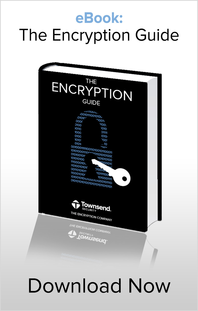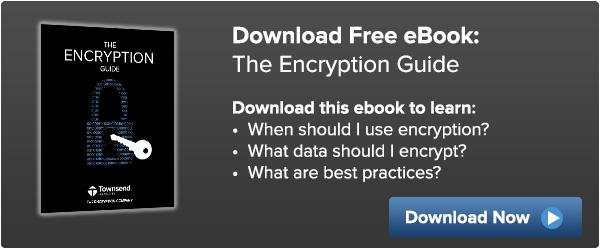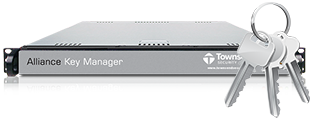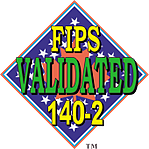 With the growing demand for regulatory compliance and concern for data privacy, organizations are taking advantage of encryption as a way to provide a "defense in depth" solution. This approach is often impractical using only database encryption management tools alone. Townsend Security has addressed this with their Alliance Key Manager Hardware Security Module (HSM). Alliance Key Manager is a FIPS 140-2 certified solution that stores encryption keys on a hardware appliance. This is a more secure approach and better meets compliance requirements because encryption keys do not reside with the encrypted data.
With the growing demand for regulatory compliance and concern for data privacy, organizations are taking advantage of encryption as a way to provide a "defense in depth" solution. This approach is often impractical using only database encryption management tools alone. Townsend Security has addressed this with their Alliance Key Manager Hardware Security Module (HSM). Alliance Key Manager is a FIPS 140-2 certified solution that stores encryption keys on a hardware appliance. This is a more secure approach and better meets compliance requirements because encryption keys do not reside with the encrypted data.
So what does an organization need to look for when selecting an encryption key management HSM?
1) Cost Effective
Cost should not be a barrier to compliance. Townsend Security's encryption key management HSM is an affordable solution that can scale from small and medium sized organizations to the largest Enterprise.
2) Meet Compliance Requirements
Compliance regulations require encryption keys to be stored separately from the encrypted data to meet Separation of Duties and Dual Control best practices. It is important to enforce separation of duties if you are trying to meet PCI-DSS. This means preventing administrators from having access to both the encrypted data and the encryption keys.
3) Invest in a FIPS 140-Certified Solution
This gives you assurance that your encryption key management solution is certified to the highest standard for regulatory compliance.
4) Easy Integration
It is important that your encryption key management solution connects effortlessly to your applications and databases.
5) Automated Key Management Process
Your organization can save time and money when addressing compliance requirements by choosing an encryption key management HSM that automates all of your essential key management tasks - including rotation, retrieval, and generation - from one server or man, in a central location.
Want to learn more? You can view a pre-recorded webinar titled "Encryption Key Management Simplified" and learn how encryption key management can be easy, why encryption key management is important, and what the barriers are to good encryption key management.




 Smart phone payment systems have exploded over the last few months offering the specter of turning every street vendor into a walking, talking, credit-card accepting, free-spirited merchant. In some cases smart phone payment vendors are giving away free card readers just by signing up. Some people saw this as the welcome exuberance of democratic capitalism with innovation driving new opportunities. Others saw this as the apocalypse for credit card security. Is there some middle ground here?
Smart phone payment systems have exploded over the last few months offering the specter of turning every street vendor into a walking, talking, credit-card accepting, free-spirited merchant. In some cases smart phone payment vendors are giving away free card readers just by signing up. Some people saw this as the welcome exuberance of democratic capitalism with innovation driving new opportunities. Others saw this as the apocalypse for credit card security. Is there some middle ground here?


 Townsend Security is heading to LA in July to attend
Townsend Security is heading to LA in July to attend 
 Last week we hosted a well-attended webinar titled "
Last week we hosted a well-attended webinar titled " When I had this “Aha” moment years ago, I realized that our company had to radically change how we approached the development of our encryption and key management products. I knew that we had to step up to much higher standards, and change how we looked at our own products. But where does one go to figure out how to do encryption right? Fortunately, our company had several good enterprise customers who helped point the way. Enterprise security architects directed us to the National Institute of Standards and Technology (NIST) web site and the FIPS-140 certification process. The NIST and FIPS-140 certification outline the proper standards and best practices for encryption, decryption, key management, and logging. So began the complete transformation in how we bring Townsend Security encryption products to market.
When I had this “Aha” moment years ago, I realized that our company had to radically change how we approached the development of our encryption and key management products. I knew that we had to step up to much higher standards, and change how we looked at our own products. But where does one go to figure out how to do encryption right? Fortunately, our company had several good enterprise customers who helped point the way. Enterprise security architects directed us to the National Institute of Standards and Technology (NIST) web site and the FIPS-140 certification process. The NIST and FIPS-140 certification outline the proper standards and best practices for encryption, decryption, key management, and logging. So began the complete transformation in how we bring Townsend Security encryption products to market. Well, you already know how this came out. In the end I could come to no other conclusion. We would either do the right thing, or get out of the security market altogether. We’re still in, so you know that we made that commitment and investment in NIST certification of our correctly implemented encryption solutions. We did learn a lot about encryption development processes and best practices. And I must say our products are so much better for it.
Well, you already know how this came out. In the end I could come to no other conclusion. We would either do the right thing, or get out of the security market altogether. We’re still in, so you know that we made that commitment and investment in NIST certification of our correctly implemented encryption solutions. We did learn a lot about encryption development processes and best practices. And I must say our products are so much better for it.
 As you probably know “Phishing” is the security term used for email that looks perfectly valid, but which contains links or attachments that can infect your PC. Really good phishing email looks like it came from someone you know, or from a business that you work with and trust. A well-crafted Phishing scheme lowers your defenses. You say to yourself, “I’m glad John got back to me on that financial plan.” Or, “I wonder why Wal-Mart is having trouble with my invoice.” And a click or two later and you’ve fallen victim to a phishing attack.
As you probably know “Phishing” is the security term used for email that looks perfectly valid, but which contains links or attachments that can infect your PC. Really good phishing email looks like it came from someone you know, or from a business that you work with and trust. A well-crafted Phishing scheme lowers your defenses. You say to yourself, “I’m glad John got back to me on that financial plan.” Or, “I wonder why Wal-Mart is having trouble with my invoice.” And a click or two later and you’ve fallen victim to a phishing attack. When encrypting data, the most widely accepted cryptographic standard is the Advanced Encryption Standard (AES).
When encrypting data, the most widely accepted cryptographic standard is the Advanced Encryption Standard (AES). There are several potential problems related to the use of the CUSP mode of AES encryption.
There are several potential problems related to the use of the CUSP mode of AES encryption. As it turns out, the weakness, in these devices, was not in the actual AES encryption, but in the key management processes. All the affected vendors quickly released replacements or patches to fix the problem, which is the right thing to do. But it was fascinating to watch some of the responses to this problem. Many commentators complained that the FIPS-140 testing was faulty, or that FIPS-140 testing was irrelevant. The implication is that FIPS-140 does not really give you any assurance of security, and therefore, also by implication, that it is not important.
As it turns out, the weakness, in these devices, was not in the actual AES encryption, but in the key management processes. All the affected vendors quickly released replacements or patches to fix the problem, which is the right thing to do. But it was fascinating to watch some of the responses to this problem. Many commentators complained that the FIPS-140 testing was faulty, or that FIPS-140 testing was irrelevant. The implication is that FIPS-140 does not really give you any assurance of security, and therefore, also by implication, that it is not important. First, FIPS-140 certification is not a guarantee of security. It is an assurance that encryption and related security algorithms have been implemented in compliance with published standards, that an application uses good practices in exposing it’s operational interfaces, that start up tests validate that the application has not been modified or corrupted, that cryptographic material is not exposed in application logs or leaked to memory, and that an independent expert has reviewed the source code. Going through a FIPS-140 certification is a grueling process for an encryption vendor and almost always results in finding some issues that need to be addressed to make the product more secure. Companies that engage in FIPS-140 certifications produce better products, and become better security designers in the process.
First, FIPS-140 certification is not a guarantee of security. It is an assurance that encryption and related security algorithms have been implemented in compliance with published standards, that an application uses good practices in exposing it’s operational interfaces, that start up tests validate that the application has not been modified or corrupted, that cryptographic material is not exposed in application logs or leaked to memory, and that an independent expert has reviewed the source code. Going through a FIPS-140 certification is a grueling process for an encryption vendor and almost always results in finding some issues that need to be addressed to make the product more secure. Companies that engage in FIPS-140 certifications produce better products, and become better security designers in the process.
 System logging has become one of the most essential tasks of contemporary corporate IT. Several IT standards and regulations, primarily in the interest of traceability (e.g.: PCI-DSS, SOX, etc.) now require it.
System logging has become one of the most essential tasks of contemporary corporate IT. Several IT standards and regulations, primarily in the interest of traceability (e.g.: PCI-DSS, SOX, etc.) now require it.